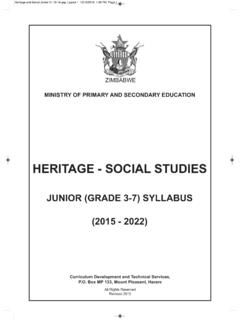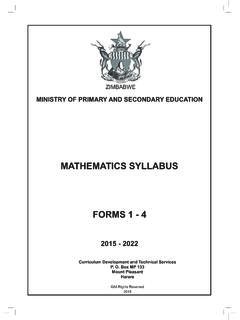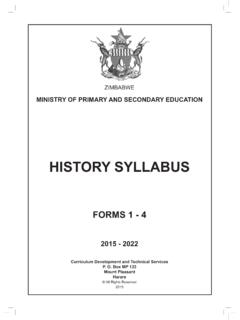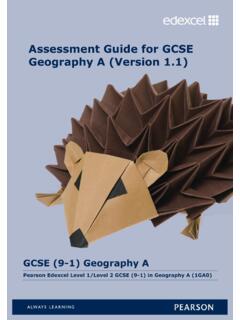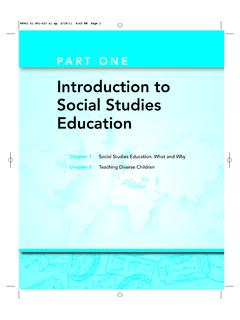Transcription of GEOGRAPHY SYLLABUS
1 MINISTRY OF PRIMARY AND SECONDARY EDUCATIONGEOGRAPHY SYLLABUSFORMS 1 - 42015-2022 Curriculum Development Box MP133 Mount PleasantHarare All Rights Reserved 2015 ZIMBABWEGEOGRAPPHY 110/26/2016 1:39:00 PMiACKNOWLEDGEMENTSThe Ministry of Primary and Secondary Education wishes to acknowledge the following for their valued contribution in the production of this SYLLABUS : National GEOGRAPHY Subject Panel Ministry of Higher and Tertiary Education Science and Technology Development Representatives from Teachers` Colleges Zimbabwe School Examinations Council (ZIMSEC) Department of GEOGRAPHY and Environmental Science (UZ) Department of Science and Mathematics Education (UZ) Department of GEOGRAPHY and Environmental Studies (MSU) Environmental Management, Renewable Energy and Climate Change Research Centre (HIT) Publishers United Nations Children s Education Fund (UNICEF) United Nations Educational Scientific Cultural Organisation (UNESCO) Civil Protection DepartmentGEOGRAPHY SYLLABUS (FORMS 1 - 4)GEOGRAPPHY 210/26/2016 1:39.
2 00 PMiiTABLE OF CONTENTSACKNOWLEDGEMENTS PREAMBLE RATIONALE ASSUMPTIONS CROSS-CUTTING themes PRESENTATION OF SYLLABUS AIMS 1 SYLLABUS OBJECTIVES 1 METHODOLOGY AND TIME ALLOCATION 2 TOPICS 2 SCOPE AND SEQUENCE 3 COMPETENCY MATRIX ASSESSMENT 92 (a) Assessment Objectives 92 b) Scheme of Assessment 92 (c) Specification Grid 96 GEOGRAPHY SYLLABUS (FORMS 1 - 4)GEOGRAPPHY 310/26/2016 1:39:00 INTRODUCTIONThis SYLLABUS is designed to cover progressively the study of GEOGRAPHY from form 1 to 4. It motivates learners to appreciate their local, national, regional and global geographical space. This will raise awareness of resource distribution, management and utilisation for the benefit of Zimbabwean citizens. The SYLLABUS seeks to equip learners with skills, attitudes, values and practical competencies that enable them to participate in the development of the country.
3 It enables response to challenges by developing solutions and skills leading to sustainable development. The SYLLABUS recognises individual special education RATIONALEG eography in the secondary school curriculum will equip learners with skills to understand location, patterns and processes of phenomena. It is designed to make learn-ers appreciate diversity, valuation, utilisation and conser-vation of resources. The learning area gives an oppor-tunity to learners to manipulate geographical data and make informed decisions in their day to day GEOGRAPHY SYLLABUS enables learners to develop the following skills: Problem solving Critical thinking Decision making Communication Technology and innovation Graphicacy The GEOGRAPHY learning area is a science that comprises both physical and human aspects. It also covers field-work, map interpretation skills and graphicacy.
4 ASSUMPTIONS It is assumed that learners: Have a natural desire to explore their environ ment have basic knowledge of direction and location constantly interact with weather phenomena in day to day life interact with natural resources are aware of people engaging in various eco nomic CROSS-CUTTING themes This phase will develop in learners, skills and an appreci-ation of: environmental issues safety and health issues disaster risk management enterprise sexuality, HIV and AIDS heritage climate change financial literacy gender technologyPRESENTATION OF SYLLABUSThe GEOGRAPHY SYLLABUS is a single document covering Forms 1 - 4. AIMS The aims of the SYLLABUS are equip learners with skills in statistical and car tographic techniques ; develop practical skills of enquiry, observation, recording and interpretation of geographical information; promote an understanding of environmental management issues; promote sustainable exploitation, processing and economic use of minerals and other resources; develop in learners an understanding of societal issues of HIV and AIDS, climate change and disaster risk management; develop an appreciation of diverse communities and cultures promote an understanding of environmental pat terns, dynamics and relationships.
5 SYLLABUS OBJECTIVESBy the end of this learning phase learners should be able demonstrate basic knowledge of geographic in formation systems (GIS) in resource manage interpret topographical maps, photographs and satellite images. collect, analyse and interpret geographical value natural resources in the context of both economic development and environmental pro- develop technologies in issues of climate change and climate change demonstrate knowledge and understanding of the processes that bring about change in both physical and human demonstrate geographical knowledge to create solutions to everyday develop in learner s enterprise skills in resource utilization and demonstrate the relationship between physi- cal and human processes in the shaping of geo graphic space METHODOLOGY AND TIME ALLOCATIONThis SYLLABUS takes into account learner centred ap-proaches and methods.
6 The choice of teaching methods and approaches should be guided by the principles of inclusivity, relevance, specificity, gender sensitivity and respect. The following approaches and methods are rec-ommended in the teaching and learning of GEOGRAPHY : GEOGRAPHY SYLLABUS (FORMS 1 - 4)GEOGRAPPHY 110/26/2016 1:39:00 PM2 The SYLLABUS proposes the use of the concentric, sys-tems and integrated concentric approach: It recommends teaching ge-ography starting from the local environment to the whole of Zimbabwe, Southern African Development Community region, the rest of Africa and the Approach: It involves the study of inter-re-lationships of various components in the environment which make up the whole. The focus is on the inputs, processes and outputs and feedback in a given integrated approach: It recommends that related topics should be taught together rather than in isolation.
7 METHODOLOGY The following are suggested methods of teaching and learning GEOGRAPHY : Demonstrations Field work Games Simulations Debates Laboratory work and experiments Group work and discussions Role-play Case studies Project based learning Educational toursNB. The above suggested methods should be enhanced by the application of orthodidactic principles and mul-ti-sensory approaches to teaching. These include tac-tility, concreteness, individualisation, self-activity, totality and wholeness. Teachers are encouraged to address the learners residual TIME ALLOCATIONFive (5) periods of 40 minutes per week should be allo-cated for adequate coverage of the SYLLABUS . The teach-ers should allocate time appropriately for learners with individual special education tours should be undertaken at least once a Weather and Natural Energy and Map work and Geographical Information systems6.
8 7 Minerals and Environmental Agriculture and land reform GEOGRAPHY SYLLABUS (FORMS 1 - 4) Settlement and population Transport and trade GEOGRAPPHY 210/26/2016 1:39:00 PM3 8 SCOPE AND SEQUENCE 1:WEATHER AND CLIMATEFORM 1 FORM 2 FORM 3 FORM 4 Weather elements and instruments Weather station Weather data Types of rainfall and distribution Weather forecasting Weather hazards Influence of people on weather Climate of Zimbabwe Climate variability Air masses Air masses affecting Zimbabwe and Southern Africa Climatic types on global scale; Interpretation of climatic data Temperate depressions Frontal systems Tropical cyclones, People s influence on climate Climate change GEOGRAPHY SYLLABUS (FORMS 1 - 4)GEOGRAPPHY 310/26/2016 1:39:00 PM4 9 2: LANDFORMS AND LANDSCAPE PROCESSESFORM 1 FORM 2 FORM 3 FORM 4 Landforms in the local area, Zimbabwe, Africa and the world and benefits of these landforms.
9 Rocks Weathering of rocks and resulting landforms Internal structure of the earth Continental Drift theory Plate Tectonics theory Folding Faulting Volcanoes and earthquakes Effects of tectonic processes Landforms resulting from:-Water action and river processes-Wind action Hazards associated with landform development processes Disaster risk management: GEOGRAPHY SYLLABUS (FORMS 1 - 4)GEOGRAPPHY 410/26/2016 1:39:00 PM5 10 3: ECOSYSTEMS FORM 1 FORM 2 FORM 3 FORM 4 Components of an ecosystem Micro ecosystems Interdependence in ecosystems (food chains and webs) Biodiversity Tropical ecosystems (biomes) Sustainable management of ecosystems Use of ecosystems in entrepreneurship Biogeochemical cycles Wetlands Conservation of ecosystems Restoration of ecosystem Benefits of ecosystems Soil components Soil forming processes in the tropics. Soil properties Soil typesGEOGRAPHY SYLLABUS (FORMS 1 - 4)GEOGRAPPHY 510/26/2016 1:39:00 PM6 11 TOPIC 4: NATURAL RESOURCES FORM 1 FORM 2 FORM 3 FORM 4 Natural resources concept Renewable and non-renewable resources Sustainable use of resources in their local area Population and resources Exploitation of resources in Zimbabwe and Africa Conservation of resources Wildlife managementGEOGRAPHY SYLLABUS (FORMS 1 - 4)GEOGRAPPHY 610/26/2016 1:39:00 PM7 12 TOPIC 5.
10 ENERGY AND POWER DEVELOPMENTFORM 1 FORM 2 FORM 3 FORM 4 Types and sources of energy Siting of power plants Power generation Environmental impact from generation and use of different energy types Economic importance of energy types Relative importance of using different energy sources Conservation of energy sources Project on use of energy in the local SYLLABUS (FORMS 1 - 4)GEOGRAPPHY 710/26/2016 1:39:00 PM8 13 6: MAP WORK AND GEOGRAPHICAL INFORMATION SYSTEMSFORM 1 FORM 2 FORM 3 FORM 4 Characteristics of a good map Types of maps Location Scale Universal symbols Direction Distance Gradient Land use Patterns and networks Location (Geographical Positioning System) and world time zones Electromagnetic spectrum Remote sensing (Photo interpretation) Boolean logic: Venn diagrams Overlay 7:MINERALS AND MININGFORM 1 FORM 2 FORM 3 FORM 4 Distribution of minerals and mines of Zimbabwe Ores and mineral groups use and Factors influencing mining in Zimbabwe Methods of mining Mineralogy Environmental impacts of mining Small scale mining in Zimbabwe Extraction and processing of minerals in Zimbabwe and Africa Environmental conservation and environmental management Environmental impact assessment in mining Sustainable utilisation GEOGRAPHY SYLLABUS (FORMS 1 - 4)GEOGRAPPHY 810/26/2016 1:39:00 PM9 14 importance of minerals Health and safety Beneficiation and value additionof mineral 8.


